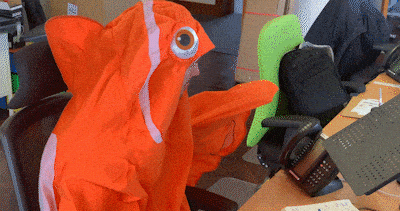- Conservation Makers
- Posts
- Stop Adjusting Content for Short Attention Spans
Stop Adjusting Content for Short Attention Spans
Why standing out is more important than being brief
Goldfish: You know, that whole thing about my attention span isn't tr—
Marketers: IT MUST BE SHORT OR NO ONE WILL PAY ATTENTION!
Friends, I have spent the last two newsletters talking about maximizing productivity and what shifts can be made in content strategy to account for the fact that every one of us is busy as all heck.
Because we ARE overwhelmed as nonprofit communications leaders. We're participating in an always-on digital world. It’s easy to assume that a chronic state of having very little time confirms the myth that the human attention span is getting shorter.
So, we put extra effort into making our content brief. More bullet points! More paragraph breaks! No talking heads! Cut it to 15 seconds! I've wrung my hands over these very same impulses.
The tricky part is that we have to capture attention before we can keep it, for whatever amount of time we can. And the fact that my blog post is short isn't all that impressive if what I've written doesn't resonate with you.

In fact, GOOD content that provides value throughout WILL be consumed, no matter how long it is.
Have you binge-watched any great TV lately? Paid attention for more than 8 seconds, right? Ever stumbled across a great Reel, went to the maker's profile, and ended up down a rabbit hole of their past content? That's some pretty deep engagement, actually.
That’s why it's way more important to craft a compelling hook than to tailor content to some average ideal viewing time.
I think the track record of character-limited and short-form platforms eventually expanding the range of what you can post is proof of this. The social network formerly known as Twitter upgraded from 140 to 280 characters in 2017 and now allows up to 4,000 characters per post. TikToks were originally limited to 15 seconds before upping max length to 60 seconds, then 3 minutes, and eventually 10 minutes (if you upload video vs making it within the app.)
This Forbes story is a great read that talks about not only how the 8-second attention span myth came to be, but also the specific challenge marketers face to capture the attention of social media users who are often watching TV at the same time. You'll like this, though: "One of the most reliable mechanisms for sustaining attention—according to actual science," Forbes says, "is storytelling."
You can't ignore best practices, of course. Please don't close this window and go write a 24-sentence Facebook ad, for example—I don't care how strong your CTA is.
DO spend a little more time thinking about the hook. It is what you should lead with in your headline, on your button, in the first 40 characters of your social post, on the first slide, in the video cover image, in the subject line, and front and center on your ad visuals.
Here are some QUICK tips on creating strong hooks:
🔮 Put 2024 in the headline or offer from now through mid-January. This is a timely recommendation from Jay Schwedelson in his latest podcast. Make it about 2024 and you're forecasting, you're a resource, you're in touch with what's next. Sorry, but 2023 is old news!
💎 Offer value, not empty hype. This marks the difference between a catchy headline and clickbait, writes Alex Cattoni of Copy Posse. You won't see a ton of "What happened next blew my mind!" in conservation, but occasionally there's fake urgency or FOMO around an offer or advocacy opportunity, and this can undermine brand loyalty.
🧠 Try the “Jeopardy clue” approach. This is one of my go-tos for headlines. Examples: "Sportsmen and Sportswomen in This State Contributed the Most to Conservation Last Year" or "This Forest Management Tactic Will Prevent Wildfire and Improve Elk Hunting." You dangle or withhold just one element of what they're going to learn if they click through, and people will be curious if it applies to them or if they can guess the answer. Just make sure you deliver fully on the promise in the linked content.
❓ Ask a question first. This naturally challenges or engages your audience. Try using "Has this ever happened to you?" or "How well do you know ____?" right at the start of an Insta caption or in the preview text (AKA the second subject line) of an email newsletter. Or make the question about a potential pain point, like, "Having trouble finding hunting access?"
👀 Make your visuals stand out. For example, if you post to Stories every day, says Manu Muraro of Your Social Team, try a black-and-white Story. Highlight your most important offers or biggest announcements by formatting those Stories with a simple black background, white text, and one link sticker. The high contrast is likely to be strikingly different than everything else your audience has just tapped through—Muraro sees engagement with these Stories go through the roof.
I hope this helps as you craft your content in Q4, when social feeds and inboxes are so saturated with nonprofit asks and offers. It’s the perfect time to consider how you want to differentiate your content and attract more eyeballs.